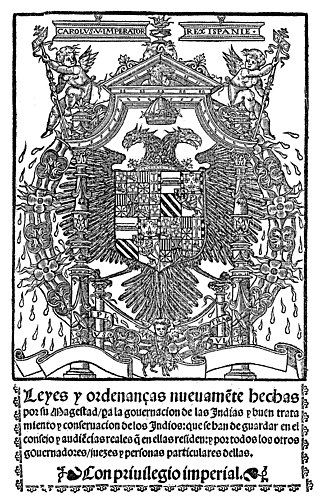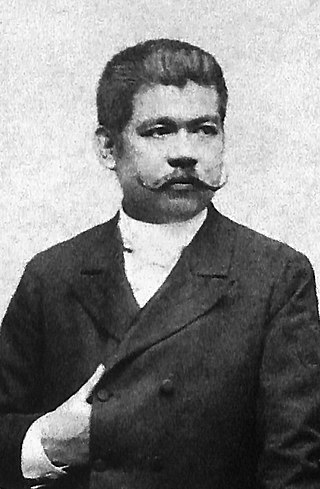Related Research Articles

A barangay, historically referred to as a barrio, is the smallest administrative division in the Philippines and is the native Filipino term for a village, district, or ward. In metropolitan areas, the term often refers to an inner city neighborhood, a suburb, a suburban neighborhood, or even a borough. The word barangay originated from balangay, a type of boat used by a group of Austronesian peoples when they migrated to the Philippines.
The term Don abbreviated as D., is an honorific prefix primarily used in Spain and Hispanic America, and with different connotations also in Italy, Portugal and its former colonies, and formerly in the Philippines.

The encomienda was a Spanish labour system that rewarded conquerors with the labour of conquered non-Christian peoples. The labourers, in theory, were provided with benefits by the conquerors for whom they laboured, including military protection and education. The encomienda was first established in Spain following the Christian reconquest of Moorish territories, and it was applied on a much larger scale during the Spanish colonization of the Americas and the Spanish East Indies. Conquered peoples were considered vassals of the Spanish monarch. The Crown awarded an encomienda as a grant to a particular individual. In the conquest era of the early sixteenth century, the grants were considered to be a monopoly on the labour of particular groups of indigenous peoples, held in perpetuity by the grant holder, called the encomendero; starting from the New Laws of 1542, the encomienda ended upon the death of the encomendero, and was replaced by the repartimiento.

The New Laws, also known as the New Laws of the Indies for the Good Treatment and Preservation of the Indians were issued on November 20, 1542, by Charles V, Holy Roman Emperor and regard the Spanish colonization of the Americas. Following denunciations and calls for reform from individuals such as the Dominican friar Bartolomé de Las Casas, these laws were intended to prevent the exploitation and mistreatment of the indigenous peoples of the Americas by the encomenderos, by limiting their power and dominion over groups of natives.
Traditional rank amongst European royalty, peers, and nobility is rooted in Late Antiquity and the Middle Ages. Although they vary over time and among geographic regions, the following is a reasonably comprehensive list that provides information on both general ranks and specific differences. Distinction should be made between reigning families and the nobility – the latter being a social class subject to and created by the former.

Datu is a title which denotes the rulers of numerous Indigenous peoples throughout the Philippine archipelago. The title is still used today, though not as much as early Philippine history. It is a cognate of ratu in several other Austronesian languages.

Solano, officially the Municipality of Solano, is a 1st class municipality in the province of Nueva Vizcaya, Philippines. According to the 2020 census, it has a population of 65,287 inhabitants..

Palapag, officially the Municipality of Palapag, is a 3rd class municipality in the province of Northern Samar, Philippines. According to the 2020 census, it has a population of 34,034 people.

Dingle, officially the Municipality of Dingle, is a 3rd class municipality in the province of Iloilo, Philippines. According to the 2020 census, it has a population of 45,965 people.
Sangley and Mestizo de Sangley are archaic terms used in the Philippines during the Spanish colonial era to describe respectively a person of pure overseas Chinese ancestry and a person of mixed Chinese and native Filipino ancestry. The Sangley Chinese were ancestors to both modern Chinese Filipinos and modern Filipino mestizo descendants of the Mestizos de Sangley., who were mestizos under the Spanish colonial empire, classified together with other Filipino mestizos.

Filipinos are citizens or people identified with the country of the Philippines. The majority of Filipinos today are predominantly Catholic and come from various Austronesian peoples, all typically speaking Filipino, English, or other Philippine languages. Despite formerly being subject to Spanish colonialism, only around 2–4% of Filipinos are fluent in Spanish. Currently, there are more than 185 ethnolinguistic groups in the Philippines each with its own language, identity, culture, tradition, and history.

A tributary state is a pre-modern state in a particular type of subordinate relationship to a more powerful state which involved the sending of a regular token of submission, or tribute, to the superior power. This token often took the form of a substantial transfer of wealth, such as the delivery of gold, produce, or slaves, so that tribute might best be seen as the payment of protection money. It might also be more symbolic: sometimes it amounted to no more than the delivery of a mark of submission such as the bunga mas that rulers in the Malay Peninsula used to send to the kings of Siam, or the Tribute of the Maltese Falcon that the Grand Master of the Order of St. John used to send annually to the Viceroy of Sicily in order to rule Malta. It might also involve attendance by the subordinate ruler at the court of the hegemon in order to make a public show of submission.

The Captaincy General of the Philippines was an administrative district of the Spanish Empire in Southeast Asia governed by a governor-general as a dependency of the Viceroyalty of New Spain based in Mexico City until Mexican independence when it was transferred directly to Madrid.

The principalía or noble class was the ruling and usually educated upper class in the pueblos of Spanish Philippines, comprising the gobernadorcillo, tenientes de justicia, and the cabezas de barangay who governed the districts. Also included in this class were former gobernadorcillos or municipal captains, and municipal lieutenants in good standing during their term of office.

The gobernadorcillo was a municipal judge or governor in the Philippines during the Spanish colonial period, who carried out in a town the combined charges or responsibilities of leadership, economic, and judicial administration. The gobernadorcillo was the leader of a town or pueblo. In a coastal town, the gobernadorcillo functioned as a port captain. They were appointed through an exclusive nomination provided by the Spanish law. Their term of office lasted for two years.
The first Philippine municipal elections were in 1895.

In early Philippine history, barangay is the term historically used by scholars to describe the complex sociopolitical units that were the dominant organizational pattern among the various peoples of the Philippine archipelago in the period immediately before the arrival of European colonizers. Academics refer to these settlements using the technical term "polity", but they are usually simply called "barangays".

Marcelo Hilario del Pilar y Gatmaitán, commonly known as Marcelo H. del Pilar and also known by his nom de plumePláridel, was a Filipino writer, lawyer, journalist, and freemason. Del Pilar, along with José Rizal and Graciano López Jaena, became known as the leaders of the Reform Movement in Spain.

Nobility is a social class found in many societies that have an aristocracy. It is normally ranked immediately below royalty. Nobility has often been an estate of the realm with many exclusive functions and characteristics. The characteristics associated with nobility may constitute substantial advantages over or relative to non-nobles or simply formal functions, and vary by country and by era. Membership in the nobility, including rights and responsibilities, is typically hereditary and patrilineal.

Jorge Augusto Gamboa Mendoza is a Colombian anthropologist and historian. He has been contributing on the knowledge of hispanic and pre-hispanic territories of what is now Colombia, especially the Muisca. Jorge Gamboa speaks Spanish and French.
References
- ↑ Scott, William Henry. Barangay Sixteenth-Century Philippine Culture and Society. Quezon City: Ateneo de Manila University Press, 1994.
- ↑ de León Pinelo, Antonio Rodríguez & de Solórzano Pereira, Juan [in Spanish], eds. (1680). Recopilación de Leyes de los Reynos de las Indias (pdf) (in Spanish). Vol. Libro Sexto.
Títulos: i De los Indios. ii De la libertad de los Indios. iii De las Reducciones, y Pueblos de Indios. iv De las caxas de censos, y bienes de Comunidad, y su administracion. v De los tributos, y tassas de los Indios. vi De los Protectores de Indios. vii De los Caciques. viii De los repastimientos, encomiendas, y pensiones de Indios, y calidades de los titulos. ix De los Encomenderos de Indios. x De el buen tratamiento de los Indios. xi De la sucession de encomiendas, entretenimientos, y ayudas de costa. xii Del servicio personal. xiii Del servicio en chacras, viñas, olivares, obrajes, ingenios, perlas, tambos, requas, carreterias, casas, ganados, y bogas. xiv Del servicio en coca, y añir. xv Del servicio en minas. xvi De los Indios de Chile. xvii De los Indios de Tucuman, Paraguay, y Rio de la Plata. xviii De los Sangleyes. xix De las confirmaciones de encomiendas, pensiones, rentas, y situaciones.
- ↑ Blair, Emma Helen & Robertson, James Alexander, eds. (1904). The Philippine Islands, 1493–1898. Vol. 16 of 55 (1609). Historical introduction and additional notes by Edward Gaylord Bourne; additional translations by Alfonso de Salvio; Norman F. Hall. Cleveland, Ohio: Arthur H. Clark Company. ISBN 978-1426484568. OCLC 769945707.
Explorations by early navigators, descriptions of the islands and their peoples, their history and records of the catholic missions, as related in contemporaneous books and manuscripts, showing the political, economic, commercial and religious conditions of those islands from their earliest relations with European nations to the close of the nineteenth century.
- ↑ de la COSTA SJ, Horacio (1965). Readings in Philippine history : selected historical texts presented with a commentary. Manila: Bookmark Inc. ISBN 9715690459. OCLC 248085925.
351 p., [6] leaves of plates : ill., ports. ; 26 cm.
- ↑ Zaide, Gregorio F (1957). Philippine Political and Cultural History Vol I. Philippine Education Company. ASIN B008Q24O10.
- 1 2 3 4 Blair, Emma Helen & Robertson, James Alexander, eds. (1904). The Philippine Islands, 1493–1898. Vol. 17 of 55 (1609–1616). Historical introduction and additional notes by Edward Gaylord Bourne; additional translations by Henry B. Lathrop. Cleveland, Ohio: Arthur H. Clark Company. ISBN 978-1426486869. OCLC 769945708.
Explorations by early navigators, descriptions of the islands and their peoples, their history and records of the catholic missions, as related in contemporaneous books and manuscripts, showing the political, economic, commercial and religious conditions of those islands from their earliest relations with European nations to the close of the nineteenth century.
- ↑ "Principalía". Enciclopedia Universal Ilustrada Europeo-Americana . Vol. XLVII. Madrid: Espasa-Calpe, S.A. 1921.